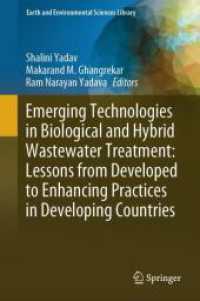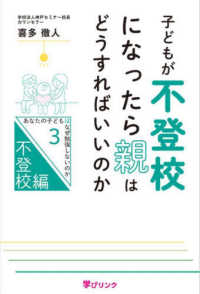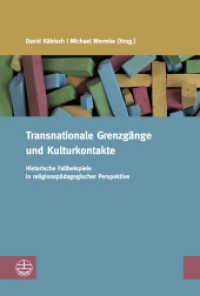Full Description
Science education is evolving-and our assessments should, too.
The Next Generation Science Standards and similar standards based on A Framework for K-12 Science Education ushered in a bold vision focused on figuring out phenomena and problems, sensemaking that mirrors how scientists work, and real-world relevance. Although instruction has started to shift, assessment has too often lagged behind—failing to capture or support the depth, complexity, and creativity of meaningful science learning.
Surfacing Brilliance Through Meaningful Science Assessment: Shifting Practice to Reflect Today's Students and Today's Standards is the essential guide for educators and leaders ready to rethink how we understand, evaluate, and support K-12 science learning. Written by Aneesha Badrinarayan, a leading voice in science education and assessment, this book offers a clear roadmap for designing assessments that surface the brilliance of young people in ways that are meaningful, equitable, and grounded in the lived realities of today's classrooms.
Drawing on four core priorities—sensemaking, relevance, assets, and opportunity—this book empowers educators to move beyond traditional tests to create assessments that reveal what students truly understand and can do.
Bridging cutting-edge research and practical implementation, this book offers:
Concrete strategies for using phenomena, problematizing strategies, and purposeful prompts to drive authentic sensemaking
Frameworks and tools to develop relevant, asset-based assessments that reflect students' strengths and experiences and are specific to a given classroom context
Approaches to using data for targeted feedback and deeper learning
A forward-looking chapter on how to meaningfully integrate AI into science assessment in an age of rapidly evolving technology
Whether you're a K-12 teacher, instructional leader, or assessment designer, Surfacing Brilliance Through Meaningful Science Assessment will transform how you think about using assessment to understand, evaluate, and support student learning. This guide ensures that educators and leaders assess students in ways that center student brilliance, embrace innovation, and inspire learners to achieve ambitious learning goals in science.
Contents
Acknowledgments
About the Author
Author's Note
PART 1: UNDERSTANDING SCIENCE STANDARDS IN FUTURE-FOCUSED WAYS
Introduction: Setting the Stage
A Quick Primer on the Next Generation Science Standards
Grounding Principles and Needed Shifts in Science Assessment
This Is Not Your Typical Science Assessment Book
Overview of This Book
Language Use in This Book
CHAPTER 1: Future-Focused Science Assessments: Interpreting the NGSS and Similar Standards for Meaningful Assessments in a Rapidly Evolving World
Understanding Our Foundation: Current Features of High-Quality Science Assessments
Landscape Shift 1: Local and Cultural Relevance and Personalization
Landscape Shift 2: Competencies and Durable Skills
Landscape Shift 3: Technology and Its Impact on Teaching, Learning, and Assessment in Science
Future-Focused Science Assessment: Evolution
Chapter Summary
Reflection Questions
PART 2: FOUR PRIORITIES FOR SURFACING SCIENCE THINKING IN TRUSTWORTHY AND USEFUL WAYS
CHAPTER 2: Priority 1: Sensemaking
Defining Sensemaking in Assessment
Why Is Sensemaking So Important?
What Leads to Sensemaking in Assessment Tasks
Pathways to Sensemaking: Phenomena, Problematizing, and Prompts
Choosing a Phenomenon to Drive Sensemaking
Problematizing a Phenomenon to Surface Sensemaking
Crafting Prompts to Elicit Sensemaking
Scaffolding Sensemaking in Assessment Tasks
Deep Dive Into Choosing Meaningful Phenomena: Right-Sizing Phenomena and Problems to a Given Assessment Task
Using Phenomena to Understand Transfer and Generalizability of Science Learning
Caution: Ensuring Transfer Doesn't Become a Pass for Discrimination and Inequity
Chapter Summary
Reflection Questions
CHAPTER 3: Priority 2: Relevance
Making Assessment Tasks Relevant—Not Just Interesting—to Learners and Their Communities
Using Culture as a Concrete Path to Relevance in Science Assessments
Understanding Our Students: An Example
Attending to Culture and Relevance at the Scale of Many Students
Windows and Mirrors: A Strategy for Approaching Relevance at Scale
Features of Culturally Conscious Assessments
Motivation and Affect: Reimagining One of Assessment's Cardinal Rules
Chapter Summary
Reflection Questions
CHAPTER 4: Priority 3: Assets
Looking for Assets in Student Sensemaking
Key Features of Asset-Based Assessment Practices in Science
Moving Beyond Misconceptions: Reframing Our Orientation to Wrong and Incomplete Answers
Implications of Asset-Based Approaches for Assessment Tasks and Data Dashboards
Habits and Beliefs of Asset-Based Assessors
Celebrating Assets of Students Who Think Differently Than We Do
Chapter Summary
Reflection Questions
CHAPTER 5: Priority 4: Opportunity and Experience
The Relationship Between Opportunity, Experience, and Performance
Making the Right Information Available
Impact on Students
A Window Into Practices and Durable Skills
What Experiences Should We Measure?
Turning Experience Information Into Insights About Opportunity to Learn That Influence Our Interpretations of Student Performance and Next Steps in Instruction
Using Opportunity and Experience Data to Foster New Conversations With Parents
Chapter Summary
Reflection Questions
PART 3: PUTTING THE PRIORITIES TO WORK
CHAPTER 6: Choosing and Designing Assessments That Center the Four Priorities
Reviewing Tasks: Criteria
Reviewing Tasks: Process
Some Tips to Help Quick Task Evaluation
Developing Assessments That Are Designed for the Science Standards in Ways That Center the Four Priorities
Step 1: Understand and Define Your Assessment Targets Within a Future-Focused Framework
Step 2: Unpack Standards and Other Learning Goals With Learners' Culture, Interests, and Identities in Mind
Step 3: Write Claims for Your Assessment That Synthesize Your Focal DCIs, SEPs, CCCs, and Durable Skills Into a Statement About Student Learning
Step 4: Choose a Phenomenon or Problem That Centers Specific Communities, Interests, and Reasons for Engaging
Step 5: Create a Problematized Scenario Based on the Phenomenon
Step 6: Develop Complete Student Explanations or Models That Specifically Account for How Different Perspectives and Ideas Can Be Valued in Complete Responses
Step 7: Develop Prompts That Elicit Sensemaking With Multiple Dimensions and Lived Experiences
Step 8: Develop Asset-Oriented Interpretation Guidance for Student Responses
Step 9: Invite Feedback and Review From Those Closest to Students You Are Least Connected To
Step 10: Pilot and Revise, Focusing on Learners at the Margins
Chapter Summary
Reflection Questions
CHAPTER 7: Using Generative AI in Responsible Ways to Support Science Assessment Design and Use
Defining Terms
Understanding the Current State of Generative AI in Science Assessment
Ways Generative AI Might Support Science Assessment
Approaching AI as a "Collaborator" in Science Assessment Activities
A Use-Case: AI in Science Assessment Review
Guiding Principles for Using Generative AI in Science Assessment Processes (AKA Aneesha's Laws of Assessment Machines)
Supporting Social Sensemaking
Some Final Caveats
Chapter Summary
Reflection Questions
CHAPTER 8: Epilogue: An Invitation to Imagine
References
Index







